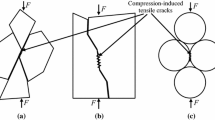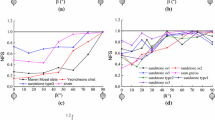Abstract
Two methods (i.e., direct tensile test and the Brazilian test) are commonly adopted to measure the tensile strength of rock, but the tensile strengths obtained by the two methods are obviously different. Taking Beishan granite as physical background, this study systematically investigates the discrepancies between the Brazilian test and direct tensile test with the use of three-dimensional Flat-joint model (FJM3D) simulation. Simulation results indicate that the Brazilian disc is under a complex three-dimensional stress state, and produce some shear cracks, which is significantly different from direct tensile test. By assigning different micro parameters to the FJM, the influences of the heterogeneity of the microstructure (particles size and pre-existing cracks) and micro-strength (bond strength) on the direct tensile strength (DTS) and the Brazilian tensile strength (BTS) are investigated. The heterogeneity of particles size, pre-existing cracks, and bond strength have negatively effects on both DTS and BTS, and that the ratio between DTS and BTS decreases with the increase of heterogeneity of pre-existing cracks and bond strength. The statistical analyses reveal that in the Brazilian disc, the contact normal stresses obey the normal distribution, but in the direct tensile specimen, the contact normal stresses obey the log-normal distribution. The three heterogeneities have minor effects on the dip direction of cracks, but significantly affect the dip angle of cracks. The heterogeneity of microstructure affects the local stress concentration, which reduces the tensile strength, and changes the orientation of cracks.



















Similar content being viewed by others

Abbreviations
- FJM3D:
-
The three-dimensional Flat-joint model
- BTS:
-
Brazilian tensile strength (MPa)
- DTS:
-
Direct tensile strength (MPa)
- P :
-
Loading force (N)
- D :
-
The Brazilian disc’s diameter (mm)
- t :
-
The Brazilian disc’s thickness (mm)
- E :
-
The Young’s modulus (GPa)
- UCS:
-
The Uniaxial compressive strength (MPa)
- \(\nu\) :
-
The Poisson’s ratio
- HPS:
-
Heterogeneity of particles size
- HPC:
-
Heterogeneity of pre-cracks
- HBS:
-
Heterogeneity of bond strength
- d max/d min :
-
The ratio between the maximum and minimum particle diameter
- Covbs :
-
The coefficient of variance of bond strength
References
Akazawa T (1943) New test method for evaluating internal stress due to compression of concrete (the splitting tension test)(part 1). J Jpn Soc Civ Eng 29:777–787
Bahaaddini M, Sharrock G, Hebblewhite BK (2013) Numerical direct shear tests to model the shear behaviour of rock joints. Comput Geotech 51:101–115. https://doi.org/10.1016/j.compgeo.2013.02.003
Blair SC, Cook NGW (1998) Analysis of compressive fracture in rock using statistical techniques: part I. A non-linear rule-based model International. J Rock Mech Min Sci 35:837–848. https://doi.org/10.1016/S0148-9062(98)00008-4
Carneiro F (1943) A new method to determine the tensile strength of concrete. In: Paper presented at the Proceedings of the 5th meeting of the Brazilian Association for Technical Rules, Brazilian 3(16): 126–129.
Chen B, Xiang J, Latham J-P, Bakker RR (2020) Grain-scale failure mechanism of porous sandstone: an experimental and numerical FDEM study of the Brazilian Tensile Strength test using CT-Scan microstructure. Int J Rock Mech Min Sci 132:104348. https://doi.org/10.1016/j.ijrmms.2020.104348
Cheng Y, Wong LNY (2020) A study on mechanical properties and fracturing behavior of Carrara marble with the flat-jointed model. Int J Numer Anal Meth Geomech 44:803–822. https://doi.org/10.1002/nag.3040
Cundall PA (2001) A discontinuous future for numerical modelling in geomechanics? Proc Inst Civ Eng-Geotech Eng 149(1):41–47. https://doi.org/10.1680/geng.2001.149.1.41
Cundall PA (1971) A computer model for simulating progressive, large scale movements in blocky rock systems. In: Proceedings of the symposium of the international society on rock fractures. Nancy, France, pp 1–12
Duan K, Kwok CY (2015) Discrete element modeling of anisotropic rock under Brazilian test conditions. Int J Rock Mech Min Sci 100(78):46–56. https://doi.org/10.1016/j.ijrmms.2015.04.023
Duan K, Kwok CY, Tham LG (2015) Micromechanical analysis of the failure process of brittle rock. Int J Numer Anal Meth Geomech 39(6):618–634. https://doi.org/10.1002/nag.2329
Duan K, Kwok CY, Pierce M (2016) Discrete element method modeling of inherently anisotropic rocks under uniaxial compression loading. Int J Numer Anal Meth Geomech 40(8):1150–1183. https://doi.org/10.1002/nag.2476
Duan K, Li XJ, Kwok CY, Zhang QY, Wang LC (2021) Modeling the orientation- and stress-dependent permeability of anisotropic rock with particle-based discrete element method. Int J Rock Mech Min Sci 147:104884. https://doi.org/10.1016/j.ijrmms.2021.104884
Fairhurst C (1964) On the validity of the “Brazilian” test for brittle materials. Int J Rock Mech Min Geomech Abstr Pergamon 1(4):535–546. https://doi.org/10.1016/0148-9062(64)90060-9
Goodman RE (1989) Introduction to rock mechanics. Wiley, New York
Griffith AA (1921) VI. The phenomena of rupture and flow in solids. Philos Trans R Soc Lond Ser A Contain Pap Math Phys Character 221(582–593):163–198. https://doi.org/10.1098/rsta.1921.0006
Hoek E (1964) Fracture of anisotropic rock. J S Afr Inst Min Metall 64(10):510–518
ISRM (1978) Suggested methods for determining tensile strength of rock materials. Int J Rock Mech Min Sci Geomech Abstr 15(3):99–103. https://doi.org/10.1016/0148-9062(78)90003-7
Itasca Consulting Group, Inc (2015) PFC—Particle Flow Code in 2 and 3 Dimensions, Version 5.0, Documentation Set of version 5.00.21. Minneapolis
Lan HX, Martin CD, Hu B (2010) Effect of heterogeneity of brittle rock on micromechanical extensile behavior during compression loading. J Geophys Res-Solid Earth. https://doi.org/10.1029/2009JB006496
Li DY, Wong LNY (2013) The Brazilian disc test for rock mechanics applications: review and new insights. Rock Mech Rock Eng 46(2):269–287. https://doi.org/10.1007/s00603-012-0257-7
Li KH, Cheng YM, Fan X (2018) Roles of model size and particle size distribution on macro-mechanical properties of Lac du Bonnet granite using flat-joint model. Comput Geotech 103:43–60. https://doi.org/10.1016/j.compgeo.2018.07.007
Liao ZY, Zhu JB, Tang BCA (2019) Numerical investigation of rock tensile strength determined by direct tension, Brazilian and three-point bending tests. Int J Rock Mech Min Sci 115:21–32. https://doi.org/10.1016/j.ijrmms.2019.01.007
Liu JF, Chen L, Wang CP, Man K, Wang L, Wang J, Su R (2014) Characterizing the mechanical tensile behavior of Beishan granite with different experimental methods. Int J Rock Mech Min Sci 69:50–58. https://doi.org/10.1016/j.ijrmms.2014.03.007
Liu CC, Zhang QY, Xiang W, Zhou XY (2020) Experimental study on characteristics and mechanism of macrography and mesoscopic failure of deep granite from Beishan. Geotech Geol Eng 38(4):3815–3830. https://doi.org/10.1007/s10706-020-01260-2
Mahabadi OK, Randall NX, Zong Z, Grasselli G (2012) A novel approach for micro-scale characterization and modeling of geomaterials incorporating actual material heterogeneity. Geophys Res Lett. https://doi.org/10.1029/2011GL050411
Mahabadi OK, Tatone BSA, Grasselli G (2014) Influence of microscale heterogeneity and microstructure on the tensile behavior of crystalline rocks. J Geophys Res Solid Earth 119(7):5324–5341. https://doi.org/10.1002/2014jb011064
Mellor M, Hawkes I (1971) Measurement of tensile strength by diametral compression of discs and annuli. Eng Geol 5(3):173–225. https://doi.org/10.1016/0013-7952(71)90001-9
Peng J, Wong LNY, Teh CI (2017) Influence of grain size heterogeneity on strength and microcracking behavior of crystalline rocks. J Geophys Res-Solid Earth 122(2):1054–1073. https://doi.org/10.1002/2016jb013469
Perras MA, Diederichs MS (2014) A review of the tensile strength of rock concepts and testing. Geotech Geol Eng 32(2):525–546. https://doi.org/10.1007/s10706-014-9732-0
Potyondy DO (2012) A flat-jointed bonded-particle material for hard rock. In: Proceedings of the 46th US Rock Mechanics/Geomechanics Symposium, Chicago, Illinois, June 2012, pp 24–27
Potyondy DO (2018) A flat-jointed bonded-particle material for rock. In: Proceedings of 52th US Rock Mechanics/Geomechanics Symposium, Seattle, Washington, June 2018
Potyondy DO, Cundall PA (2004) A bonded-particle model for rock. Int J Rock Mech Min Sci 41(8):1329–1364. https://doi.org/10.1016/j.ijrmms.2004.09.011
Shu B, Liang M, Zhang S, Dick J (2019) Numerical modeling of the relationship between mechanical properties of granite and microparameters of the flat-joint model considering particle size distribution. Math Geosci 51(3):319–336. https://doi.org/10.1007/s11004-018-09780-7
Tan X, Konietzky H, Chen W (2016) Numerical simulation of heterogeneous rock using discrete element model based on digital image processing. Rock Mech Rock Eng 49(12):4957–4964. https://doi.org/10.1007/s00603-016-1030-0
Wang YS, Deng JH, Li LR, Zhang ZH (2019) Micro-failure analysis of direct and flat Loading Brazilian tensile tests. Rock Mech Rock Eng 52(11):4175–4187. https://doi.org/10.1007/s00603-019-01877-7
Wu SC, Xu XL (2016) A study of three intrinsic problems of the classic discrete element method using flat-joint. Model Rock Mech Rock Eng 49(5):1813–1830. https://doi.org/10.1007/s00603-015-0890-z
Xu X, Wu S, Gao Y, Xu M (2016) Effects Of micro-structure and mico-parameters on Brazilian tensile strength using flat-joint model. Rock Mech Rock Eng 49(9):3575–3595. https://doi.org/10.1007/s00603-016-1021-1
Yang SQ, Yin PF, Huang YH (2019) Experiment and discrete element modelling on strength, deformation and failure behaviour of shale under Brazilian compression. Rock Mech Rock Eng 52(11):4339–4359. https://doi.org/10.1007/s00603-019-01847-z
Ye J, Yang Y, Chang Z, Wang Y (2009) Airy stress function method for analytical solution of stress field during Brazilian disk test. J Eng Geol 17(4):528–532 (in Chinese)
Zhang X, Wong LNY (2013) Loading rate effects on cracking behavior of flaw-contained specimens under uniaxial compression. Int J Fract 180(1):93–110. https://doi.org/10.1007/s10704-012-9803-2
Zhang Q, Duan K, Xiang W, Yuan S, Jiao Y-Y (2017) Direct tensile test on brittle rocks with the newly developed centering apparatus. Geotech Test J 41(1):92–102. https://doi.org/10.1520/gtj20160301
Zhang Y, Feng XT, Yang CX, Zhang XW, Sharifzadeh M, Wang ZF (2019) Fracturing evolution analysis of Beishan granite under true triaxial compression based on acoustic emission and strain energy. Int J Rock Mech Min Sci 117:150–161. https://doi.org/10.1016/j.ijrmms.2019.03.029
Zhang S, Wu S, Zhang G, Guo P, Chu C (2020) Three-dimensional evolution of damage in sandstone Brazilian discs by the concurrent use of active and passive ultrasonic techniques. Acta Geotech 15(2):393–408. https://doi.org/10.1007/s11440-018-0737-3
Acknowledgements
This work is supported by the National Natural Science Foundation of China (No.:51909138) and the Shandong Provincial Natural Science Foundation (No.:ZR2020YQ44).
Author information
Authors and Affiliations
Corresponding author
Additional information
Publisher's Note
Springer Nature remains neutral with regard to jurisdictional claims in published maps and institutional affiliations.
Rights and permissions
About this article
Cite this article
Jiang, R., Duan, K. & Zhang, Q. Effect of Heterogeneity in Micro-Structure and Micro-Strength on the Discrepancies Between Direct and Indirect Tensile Tests on Brittle Rock. Rock Mech Rock Eng 55, 981–1000 (2022). https://doi.org/10.1007/s00603-021-02700-y
Received:
Accepted:
Published:
Issue Date:
DOI: https://doi.org/10.1007/s00603-021-02700-y



